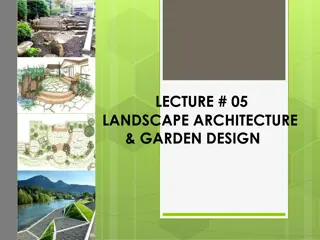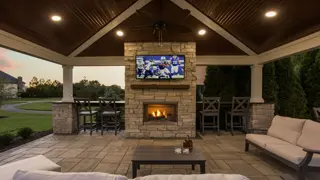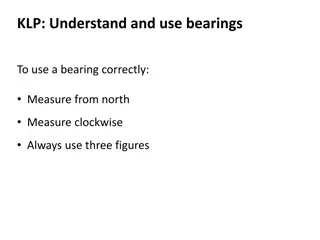Understanding Landscape Architecture: Designing Outdoor Environments
Landscape architecture involves the art and practice of designing outdoor spaces to harmonize with buildings, roads, and natural surroundings. It is a comprehensive discipline that encompasses land analysis, planning, design, management, and preservation, creating healthy and enjoyable spaces for the future. Landscape architects shape and protect the physical environment through various project types like parks, campuses, and ecological restoration. It is a profession that combines art, science, and ecological design to create sustainable outdoor environments that meet users' needs.
Download Presentation

Please find below an Image/Link to download the presentation.
The content on the website is provided AS IS for your information and personal use only. It may not be sold, licensed, or shared on other websites without obtaining consent from the author. Download presentation by click this link. If you encounter any issues during the download, it is possible that the publisher has removed the file from their server.
E N D
Presentation Transcript
DEFINITION The art and practice of designing the outdoor environment, especially designing gardenia (outside houses), green belts, lawns, parks or gardens to harmonize with buildings and roads.
WHAT IS LANDSCAPE ARCHITECTURE? A comprehensive discipline of land analysis, planning, design, management, preservation, and rehabilitation. A profession committed to creating healthy, enjoyable and secure places for the future.
A profession that designs, plans and manages our land and its resources. Landscape architects shape and protect the physical environment in which we live, work and play.
PROJECT TYPES: Zoos Parks and Public Areas Campus Planning Recreation and Event Spaces Community Planning Planning Regional and Natural Areas Corporate Facilities Ranches Residences, Estates and Cultural and Historic Sites Management Resource and Environmental Ecological Restoration and Reclamation Planning Tourism Facilities Golf Courses Transportation Planning Institutional Design and Planning Urban Planning and Design Memorials and Sculpture Gardens Waterfronts and Greenways
WHAT IS LANDSCAPE ARCHITECTURE? NOT JUST ART ART
WHAT IS LANDSCAPE ARCHITECTURE? + ART ART SCIENCE SCIENCE
WHAT IS LANDSCAPE ARCHITECTURE? + ART ART SCIENCE = SCIENCE = ECOLOGICAL ECOLOGICAL DESIGN DESIGN
Two resources of designing landscape architecture Natural Man made
Landscape Architects design outdoor spaces to serve specific purposes and meet certain needs of the users.
Elements of Design Design Elements create moods or feeling of the Observer: Form- Geometric shape or combination of shapes
Elements of Design Line Continuity of a landscape .Flow of the landscape Straight lines = direction change Curved lines= relaxed movement
Element of Design Texture: Coarse or fine materials used. Examples. Size differences of leaves stones brick bark
Elements of Design: Overview The five elements of landscape design include: Color - It is important to use a complementing color scheme throughout the yard. Line - Linear patterns are used to direct physical movement and to draw attention to areas in your garden. Form - Form can be expressed through trees and shrubs of various shapes and sizes which create natural patterns. Texture - Plants with varying textures can add to the atmosphere of your outdoor area. Scale - Your outdoor design should balance the size of the buildings it surrounds, while maintaining a comfortable environment for the individuals who will use the area.
Principles of Design Principles of design- Standards by which designs can be created, measured, discussed and evaluated.
Principles of Design Balance: Even distribution of materials on opposite sides of a central axis. Symmetric both sides are identical (mirror image). Asymmetric visual weight on opposite sides is the same, but materials used and their placement may vary. Proximal/Distal Same as asymmetric with depth in the field of vision added.
Principles of Design: Focalization Selects and positions visually strong items into landscape. Catchs and draws viewer to key feature in landscape. Hardscapes Color movement Unique plant or Specimen plant
Principles of Design: Simplicity Seeks to make the viewer feel comfortable within the landscape.
Principles of Design: Proportion Concerned with size relationship between all the features of the landscape.
Principles of Design: Rhythm and Line: When something repeats itself enough times with a standard distance between repetitions, rhythm is established.
Principles of Design: Unity The master principle combining all other principles. Total design
Architects, city planners, engineers, scientists and other professionals, can play an important role in environmental protection through collaborative projects and discourse that respect both the needs of people and of our environment.























